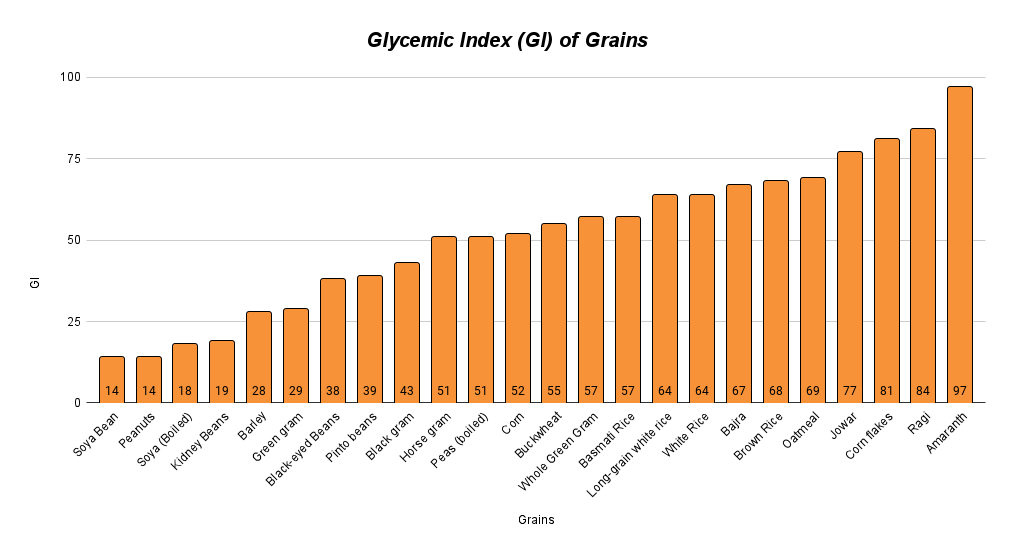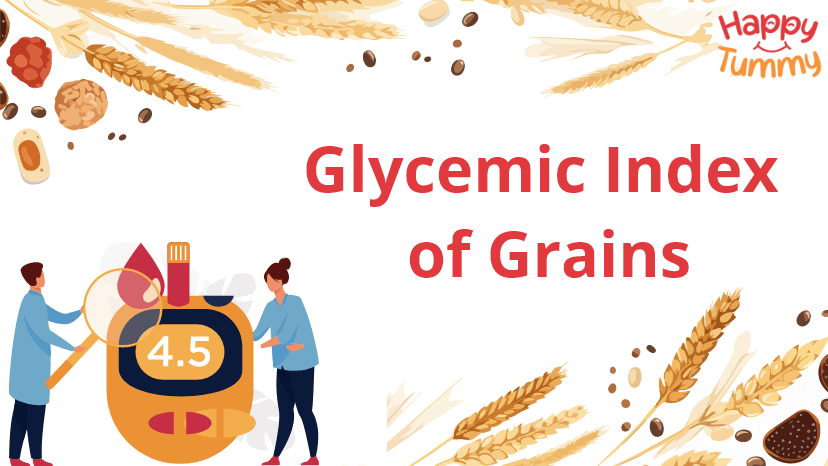Table of Contents
In today’s fast-paced lifestyle, instant meals and go-to snacks have become a routine, making weight management and maintaining energy levels challenging.
If you strive for healthy living, then knowing about the glycemic index (GI) of grains can make a huge difference.
The glycemic index ranks foods based on how quickly they can raise blood sugar levels [1].
What is the Glycemic Index?
The GI is an indicator of the quality of carbohydrates in food and measures the rapidity of increment in plasma glucose after ingestion of a food item. GI is evaluated by calculating the area under the curve for blood glucose rise for 2 hours after consuming 50 g of a test food compared to that of 50 g of oral glucose (preferably) or white bread (reference food) [9].
A value of 100 represents a rise in blood glucose similar to pure glucose. The GI of foods varies from 0 to 100. Foods with a low GI produce a lower rise in blood glucose during the first 2-3 hours after their ingestion.
Glycemic Index Classification
To understand glycemic index classification, you must know about Glycemic Load. As given in the book, “The Glycemic Index: Applications in Practice” by Elena Philippou, “It is the measure of the overall glycemic impact of the food and the product of food’s GI and the amount of carbohydrate it provides.” [2]
GL = (GI * amount of carbohydrate) / 100
| Glycemic Index Classification [3] | |
| Glycemic Index (GI) Category | Values |
| Low GI | 55 or less |
| Medium GI | 56-69 inclusive |
| High GI | 70 or higher |
Low GI foods have less of an effect on blood glucose levels than foods with a high GI [4]
Are you still confused about low-GI foods? Schedule a 45-minute consultation with a licensed nutritionist for a personalized nutrition plan tailored to your needs.
Glycemic Index and Grains
Grains are an essential part of the human diet. They have a wide variety of GI values. Intake of whole grains may have been associated with lower risks of Type 2 diabetes and weight gain [5].
Low-GI grains like quinoa, barley, and brown rice tend to release glucose more slowly, providing a steady energy source [6].
In comparison with high-GI foods, blood sugar may spike, which leads to energy crashes and more cravings.
To learn about low-GI diet, you can read the article – Low Glycemic Index Foods: Nourishing Carbs Choices.
Here is the complete list of the Glycemic Index of Grains [7] [8].
| Name of the Grain | Glycemic Index | Low/ Medium/ High | Source |
| Pinto beans | 39 | Low | [7] |
| Black gram | 43 | Low | [12] |
| Corn | 52 | Low | [10] |
| Green gram | 29 | Low | [7] |
| Horse gram | 51 | Low | [7] |
| Amaranth | 97 | High | [11] |
| Peas (boiled) | 51 | Low | [7] |
| Kidney Beans (uncooked) | 19 | Low | [7] |
| Whole Green Gram | 57 | Medium | [7] |
| Soya (Boiled) | 18 | Low | [8] |
| Soya Bean | 14 | Low | [9] |
| Black-eyed Beans | 38 | Low | [7] |
| Buckwheat | 55 | Low | [7] |
| Bajra | 67 | Medium | [7] |
| Jowar | 77 | High | [7] |
| Ragi | 84 | High | [7] |
| Corn flakes | 81 | High | [7] |
| Long-grain white rice | 64 | Medium | [8] |
| Basmati Rice | 57 | Low | [8] |
| White Rice | 64 | Medium | [8] |
| Brown Rice | 68 | Medium | [8] |
| Peanuts | 14 | Low | [8] |
| Barley | 28 | Low | [7] |
| Oatmeal | 69 | Medium | [7] |

Easy Tips to Incorporate More Low-GI Foods into Your Diet
The following are some simple ways to increase your intake of low-GI foods:
- Opt for fresh produce instead of fruit drinks and canned fruits.
- Make sure to eat more whole pulses rather than ground ones.
- Minimize cereals with little fiber and processed grains. On the other hand, you may lean more toward whole-grain options like brown bread, chapati, pasta, cereal, and rice.
- You may swap out potato and yam starchy veggies for high-fiber ones like broccoli, cauliflower, green beans, carrots, tomatoes, cucumbers, and leafy greens.
- Snack on some nuts, such as peanuts, almonds, and walnuts.
- The consumption of seeds, including chia, sabja, fennel, sunflower, and flax seeds, should be increased.
- Stay away from fast meals, processed foods, and street food.
Our AASHIRVAAD Sugar Release Control Atta is a one-of-a-kind “Special Grain Mix” that incorporates flours from legumes, pulses, and whole wheat. Give it a try!
Also, the combination of oats and methi makes this atta rich in protein and fiber. Because of its low Glycemic Index, it regulates your body’s rate of sugar release, preventing spikes.
Long Story Short
Foods are ranked according to their effect on blood sugar levels by the glycemic index. After that, you may find eggs, almonds, legumes, cereals, and a variety of fruits and vegetables on the glycemic index. Blood sugar spikes may be lessened by consuming these meals since they are either low in carbs or rich in protein and fiber.
As you wrap up your study on GI grains, bear in mind that little changes may add up to significant benefits for your health. Not only will you be eating better when you make the little adjustments, but you’ll also be setting yourself up for more energy and better overall health.
Frequently Asked Questions
It is the way of ranking foods containing carbohydrates based on how quickly they can be digested to increase the blood glucose level.
Foods that do not contain carbohydrates are considered zero glycemic foods.
Foods that tend to have a GI index of 70 or higher are considered as high glycemic foods. Generally, processed foods, sugar-containing foods, canned foods and bakery foods made with refined flour and sugar have high GI index.
Foods with a GI index of 55 or less are considered low-GI foods. These may include green leafy vegetables, other vegetables, fruits, chickpeas, lentils, and some grains.
















